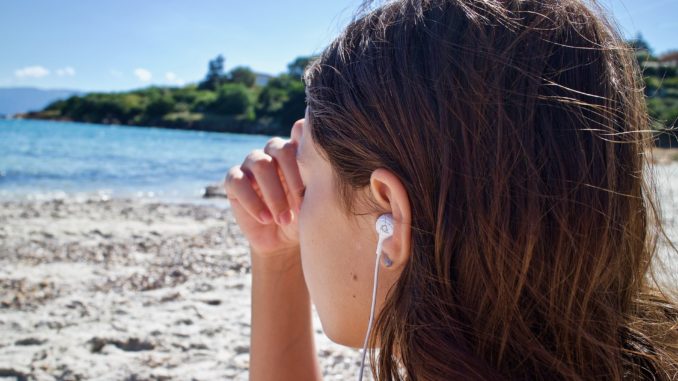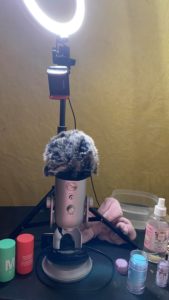
Reassuring smiles and soft voices greet you once the video begins. They speak positive affirmations, whispering ‘everything is going to be okay’ and that ‘you’re good’ as their hand reaches forward, as if to tuck a strand of hair behind your ear.
If you haven’t heard of it before, this is what a typical ASMR video would look like – an exceedingly personal experience intended to comfort and calm you.
Autonomous sensory meridian response, more colloquially known as ‘ASMR’, is a physical and emotional response to different triggers such as tapping, whispering, and even visuals like folding laundry, in some cases.
“Most people describe it as a relaxing and tingling experience, almost like a pleasant chill that runs down their spine,” explained Professor David Alais from the School of Psychology at the University of Sydney. It begins in the scalp around the head and neck, and can run down the back, arms, and legs.
Not everyone gets ASMR, but those who get it say that they’ve been experiencing it since they were kids.
“The ‘personal attention’ of ASMR videos, providing care and comfort, can go back to early experiences as a child of someone tucking you into bed, combing your hair, and whispering in your ear,” he added.
ASMR videos are a thriving community on social media, especially Youtube. According to The New York Times, there are approximately 500 new videos uploaded per day. These videos can vary in genre like munching on food, non-verbal activities of typing on a keyboard or writing, tarot card readings, and even role-plays of spa appointments or medical exams.
A few studies have tried to understand the science behind the phenomenon.
“The brain can be divided into 2 major cognitive networks: one that is active during tasks and one that’s the ‘default mode’ linked to imagination. It’s generally understood that you can’t be in both modes at the same time,” Professor Alais explained, “There is a theory emerging that perhaps there’s a different pattern of connectivity in the default mode network of people that get ASMR, that they are able to simultaneously be in both modes.”
Until there’s more research to back these theories, discussions on ASMR are largely anecdotal, but avid ASMR listeners attest to its calming abilities.
According to Akanksha Chudgar, a recent graduate from the University of Northern British Columbia, these videos help ease her anxiety.
“When I’m on a thought loop, and all my attention is on my thoughts, the videos divert my attention to my body. It shifts my energy to reduce overthinking and anxiety,” Chudgar said.
For the last six months, she has been watching (and listening) to tarot reading and reiki ASMR videos at least three times a week. She credits them as an outlet for interaction while social distancing.
“I’m naturally an empathetic person, so I pick up on other people’s energies. Now that there’s lesser human interaction during the pandemic, ASMR videos are my energy intake,” the student elaborated.
Many ASMRtists, as they call themselves, started off as listeners too. For US-based ASMRtist Brittney Janitz, who goes by ‘Brittney ASMR’, ASMR videos stemmed from a struggle with insomnia-based anxiety.
Like many ASMRtists, she see herself as a friend during these stressful times.
“I think people want comfort during the pandemic. You can’t see your friends and loved ones, and some people are isolating by themselves. ASMR videos are a good outlet to seek comfort and safety,” she explained.
Janitz’s channel includes over 50 videos since her first upload in early 2019 and over the years, she’s expanded to platforms like Youtube, Tiktok, Instagram, and Facebook. While she admits that she hasn’t grown much as a creator in this time, she has seen her largest spike in viewers since lockdowns began.
She isn’t alone in her observation.

According to Italy-based ASMRtist Valentina, who goes by Starling ASMR, she’s noticed a 20 per cent increase in viewership in the last two months alone.
“My channel is fairly new, but I have noticed quite a big spike in views. Since this is a very stressful period, ASMR videos have a stronger appeal to people that are being affected by the epidemic,” she said.
As a longtime viewer of ASMR videos to sleep and relax, Valentina decided to start her own channel in late 2019 to help others, experiment with the format, and have fun. Since losing her position as a clothes designer due to the pandemic, these videos have become her primary occupation.
Along with job losses and health concerns, the pandemic has brought up a range of other worries. It’s no wonder, then, that new studies suggest an increase in mental health issues during COVID-19. Many governments have also recognised these concerns, such as the Australian government’s investment of $48.1 million in the National Mental Health and Wellbeing Pandemic Response Plan.
As to a tangible link between the pandemic and the rising popularity of ASMR videos, Professor Alais of the University of Sydney remains on the fence.
“It could be a fad, a curiosity of ASMR as the videos become more widely known. Certainly a lot of people are finding these times stressful. Maybe people are trying to find anything that might work,” he suggested.
According to the professor, who studies cross-modal perception, perhaps lockdowns could’ve led more people to notice their ASMR for the first time.
“When you’re shut in at home, it’s the chance to unwind and perhaps you notice, for the first time, that you do get that feeling. In a normal hectic day, maybe you’d never have noticed,” he proposed.
Regardless of its sceptics, ASMR videos seem to be here to stay. Youtube channels such as Gibi ASMR and ASMR Glow have amassed over a million subscribers each, and the phenomenon warranted its own episode on Follow This, a Netflix documentary series.
There’s certainly something about the tingles that’s got listeners hooked, and being stuck at home seems to have been the ideal situation for many to find out what it is.





Be the first to comment